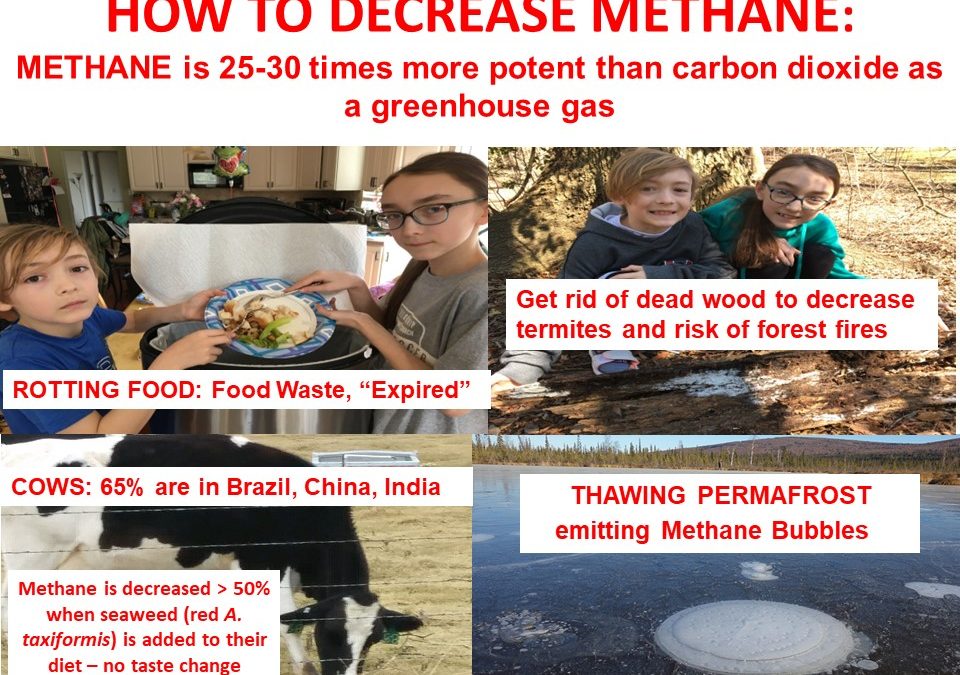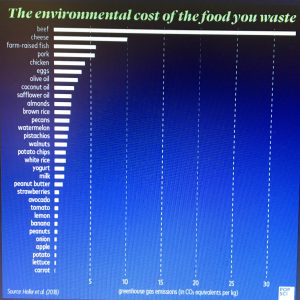September 9, 2018 – Updated June 5, 2019
We do not diagnose disease or recommend a dietary supplement for the treatment of disease. You should share this information with your physician who can determine what nutrition, disease and injury treatment regimen is best for you. You can search this site or the web for topics of interest that I may have written (use Dr Simone and topic).
“We provide truthful information without emotion or influence from the medical establishment, pharmaceutical industry, national organizations, special interest groups or government agencies.” Charles B Simone, M.MS., M.D.
HOW TO DECREASE METHANE AND BE HEALTHY: ROTTING FOOD IN LANDFILLS, TERMITES, COWS, PERMAFROST
https://bit.ly/2DZekoc
Lawrenceville, NJ (Dr Charles Simone) – A healthy diet will decrease diseases, decrease the potent greenhouse gas – methane, decrease carbon footprint by about 30%, and decrease the risk of war and piracy.
******************************************************************
SUMMARY RECOMMENDATIONS OF CHARLES SIMONE, M.MS, M.D.
METHANE: Carbon dioxide has been considered to be the leading cause of global warming but methane is 25 to 30 times more potent than carbon dioxide as a greenhouse gas. Therefore, even though governments and Nobel Laureates focus on carbon taxes, the real emphasis should be on minimizing and eliminating methane sources rather than focusing on burning of fossil fuels like coal, oil and natural gas. Methane sources: (1) cows and other grazing animals, (2) rotting food in landfills [For the average family of 4 in America, food waste costs between $1500 and $2200 per year], (3) termites, and (4) thawing permafrost – below.
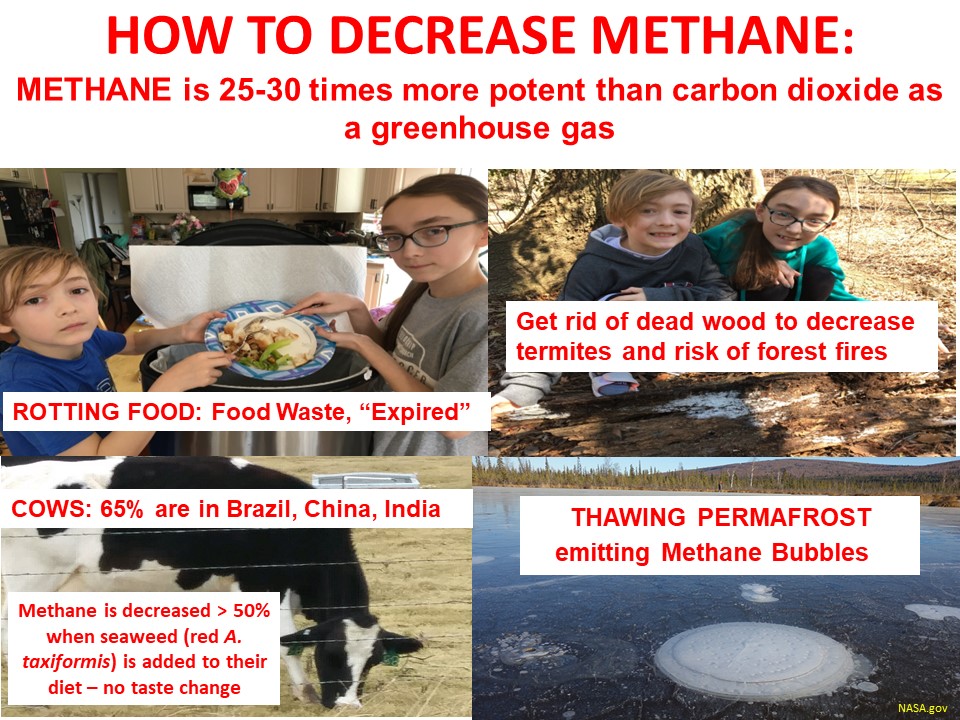
PERSONAL RESPONSIBILITY We must have a healthy diet that will decrease the demand for meats, fats, and sugar, and increase the consumption of high fiber foods.
GOVERNMENT must also encourage healthful living. Climate change will still continue even if we eliminate the use of fossil fuels unless we decrease methane production, and decrease desertification. We must devise an international system of methane taxes and credits just as we have done for carbon emissions. Globally there are about 1.5 billion cows, leading producer of methane (65% are in Brazil, China, and India).
Methane production is decreased by more than 50% when cows eat their normal diet mixed with seaweed (red macroalga Asparagopsis taxiformis) because more halogenated methane analogues are produced. The seaweed did not change the taste of milk or ice cream.
*******************************************************************
HOW TO DECREASE METHANE
Carbon dioxide has been considered to be the leading cause of global warming but methane is 25 to 30 times more potent than carbon dioxide as a greenhouse gas. Therefore, even though governments and Nobel Laureates focus on carbon taxes, the real emphasis should be on minimizing and eliminating methane sources (cows and other grazing animals, rotting food in landfills, termites, thawing permafrost) rather than focusing on burning of fossil fuels like coal, oil and natural gas. In fact, the Global Warming Potential (GWP), a measure of how much heat a greenhouse gas traps in the atmosphere of carbon dioxide is 1, whereas the Global Warming Potential (GWP) of methane is 86 over 20 years and 34 over 100 years.
Methane is a more potent greenhouse gas than carbon dioxide but the 477 page U.S. Global Change Research Program (released November 23, 2018), announced by news anchors on three different channels using the word “dire”, emphasizes carbon dioxide while minimizing methane. The word methane was written only 107 times, 36 of those are in the scientific references. Virtually all of the 71 uses of the word methane (multiple uses in the same paragraph) are linked to thawing permafrost, the fourth most common source of methane. The major sources of methane are cows and other grazing animals, rotting food in landfills, and termites (below).
Some Highlights of the U.S. Global Change Research Program
“The global atmospheric carbon dioxide concentration has now passed 400 parts per million (ppm), a level that last occurred about 3 million years ago, when both global average temperature and sea level were significantly higher than today.” [Dr. Simone: There were no humans burning fossil fuels then].
“Methane and black carbon aerosols exert stronger warming effects than carbon dioxide on a per ton basis.”
Other reports that sound the alarm about carbon dioxide can be flawed. SCIENTISTS ADMIT ERROR OF HOW FAST OCEANS ARE WARMING. Authors of a major study that claimed the Earth’s oceans are warming faster (60% more heat) than previously thought now admit to flagrant flaws only after a well respected outside scientist, Nicholas Lewis, calls them on it. Lewis has argued in past studies and commentaries that climate scientists are predicting too much warming because of their reliance on computer simulations, and that current data from the planet itself suggests global warming will be less severe than feared.
The study was published in the prestigious journal Nature, had extensive media and online coverage, and its authors were from Princeton University, Scripps, China, Paris, Germany and the U.S. National Center for Atmospheric Research and Geophysical Fluid Dynamics Laboratory. The authors submitted corrections to Nature, but will the corrections be buried somewhere in the journal and will the media inform everyone with the same zeal?
Nicholas Lewis writes:
“Obviously doubtful claims about new research regarding ocean content reveal how unquestioning Nature, climate scientists and the MSM (Main Stream Media) are.
The findings of the Resplandy et al paper were peer reviewed and published in the world’s premier scientific journal and were given wide coverage in the English-speaking media. Despite this, a quick review of the first page of the paper was sufficient to raise doubts as to the accuracy of its results. Just a few hours of analysis and calculations, based only on published information, was sufficient to uncover apparently serious (but surely inadvertent) errors in the underlying calculations.
Moreover, even if the paper’s results had been correct, they would not have justified its findings regarding an increase to 2.0°C in the lower bound of the equilibrium climate sensitivity range and a 25% reduction in the carbon budget for 2°C global warming.
Because of the wide dissemination of the paper’s results, it is extremely important that these errors are acknowledged by the authors without delay and then corrected. Of course, it is also very important that the media outlets that unquestioningly trumpeted the paper’s findings now correct the record too. But perhaps that is too much to hope for.”
By 2050 the world’s population is predicted to be 9 billion people and crop yields must increase by 50%. The global market supplies most of the world’s food supply and relies on three crops: corn (maize), wheat, and rice. Most of this goes to feed livestock. The publication called Chokepoints and Vulnerabilities in Global Food Trade by the Chatham House shows that the global food system relies on getting through 14 chokepoints: the Panama Canal, Suez Canal, Black Sea ports, Black Sea rail, Turkish Straits, Strait of Gibraltar, Dover Strait, Strait of Hormuz, Strait of Bab al-Mandab, Strait of Malacca, US Gulf Coast ports, US inland waterways and rail network, Brazil’s southern ports, and Brazil’s road network. These chokepoints are subject to weather, war, piracy, and other vulnerabilities.
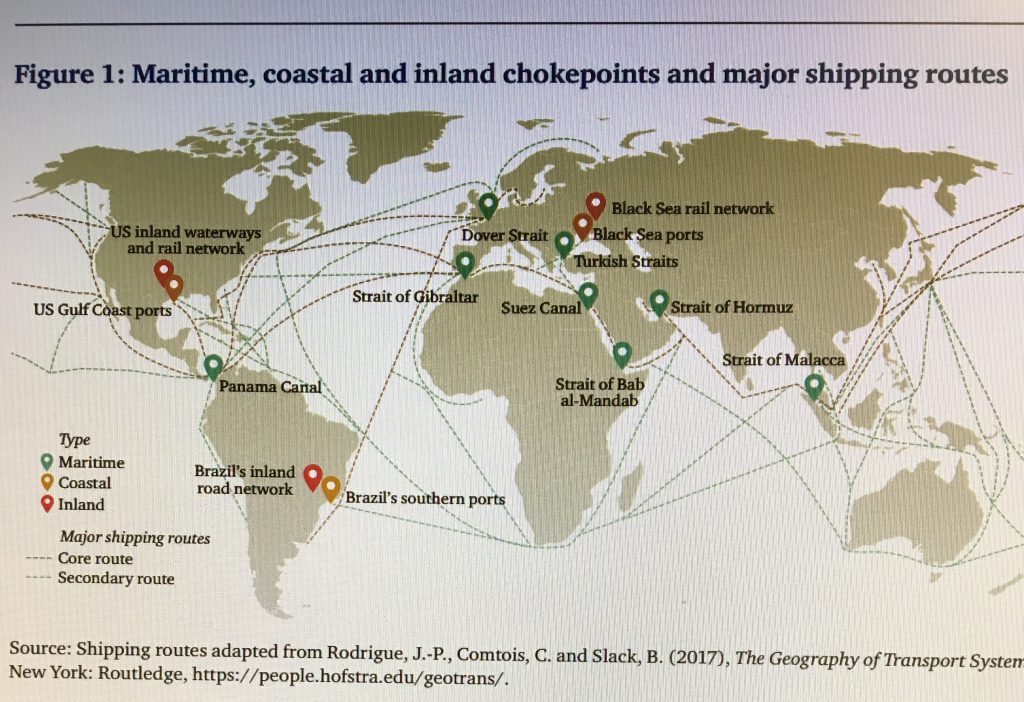
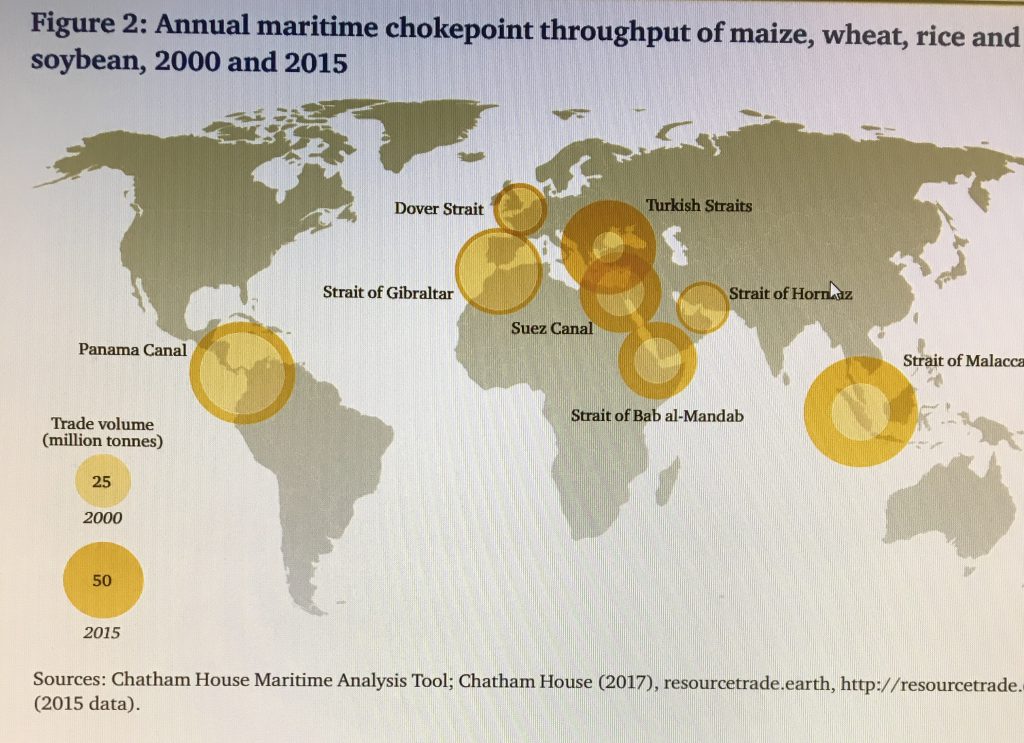
But crop yields will probably not increase because of many issues including desertification – a process in which land becomes desert caused by cattle, sheep, and goats that produce methane and overgraze the plants leaving the soil bear. It occurs in approximately two-thirds of the earth’s grasslands. Look at the overlap between the maps showing the chokepoints and the NASA map below showing areas of desertification.
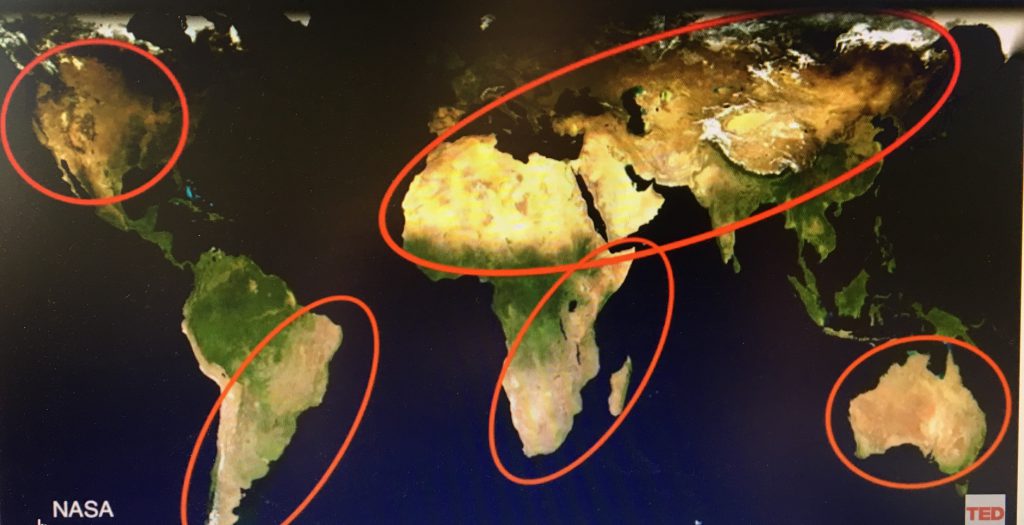
Desertification of the Earth from NASA images
Preventing further desertification is important. “Planned Grazing” (Allan Savory) may be one solution although it has not been thoroughly peer reviewed by other scientists. Planned Grazing puts large herds together for one night in a small area of land, then they are moved to another location. The land is covered with dung and urine that biologically decay the trampled (aerated) vegetation. The soil then can absorb and hold the rain, the new grass can store carbon and breakdown methane. However, the herds do produce methane.
Healthy foods result in better health outcomes and lower carbon production. However, the current world’s population has demanded a more westernized diet that dramatically increases the risk for cancer and other chronic diseases: high in meat, cheese, processed foods, high in sugar and saturated fats, and low in fiber. This was the subject of our first book in 1980, Cancer and Nutrition.
When people take personal responsibility for their health by eating low-fat, low sugar, high-fiber foods, their health will improve, there will be less risk for war and piracy because there will be less demand for these foods, the carbon footprint can be reduced by 30%, and there will be a reduction in the consumption of meat and cheese and hence a reduction in the production of the major greenhouse gas, methane.
Greenhouse gases warm the atmosphere and include water vapor, carbon dioxide, methane, nitrous oxide, and ozone. Carbon dioxide has been considered to be the leading cause of global warming but methane is 25 to 30 times more potent than carbon dioxide as a greenhouse gas. Methane rises into the air, reacts with hydroxyl radical to form water vapor and carbon dioxide. Methane’s lifespan in the atmosphere is about 9.6 years. The U.S. Food and Agriculture Organization says that methane output could increase by 60 percent by 2030 [Source: Times Online].
SOURCES OF METHANE
LANDFILLS – ROTTING FOOD: FOOD WASTE, “EXPIRED FOOD” – each person throws away about 1/2 pound of food every day accounting for about 34% of all methane emissions. About 33% of the world’s agricultural land area grows food that ultimately is wasted.
Rotting food (Food Waste and “Expired” Food) is from:
34% – Consumers in America, Europe, China, Japan, South Korea – they often buy more than they need and let it rot before they use it; or throw away good food that has a date that indicates it is expired thinking the expiration date is related to safety when in reality it is related to quality of taste. For the average family of 4 in America, food waste costs between $1500 and $2200 per year.

#STOP FOOD WASTE STOP CLIMATE CHANGE
Christina’s and Nicholas’s Initiative is to inform people that methane is produced by food waste and this leads to climate change. Methane is 25 to 30 times more potent than carbon dioxide as a greenhouse gas.


U.S. school cafeterias waste about 530,000 tons of food per year that equals 1.9 million metric tons of greenhouse gases, 20.9 billion gallons of water, and $1.7 billion.
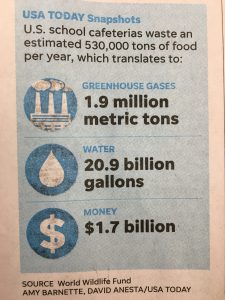

#STOP FOOD WASTE STOP CLIMATE CHANGE
Christina shows food waste at her school. Her and Nicholas’s Initiative is to inform people that methane is produced by food waste and this leads to climate change. Methane is 25 to 30 times more potent than carbon dioxide as a greenhouse gas.
33% – Agriculture itself
33% – Handling/storage, Processing, Distribution
Landfill Methane Capture is already successfully in use. https://archive.epa.gov/climatechange/kids/solutions/technologies/methane.html
TERMITES globally produce about 20 million tons of methane each year. Get rid of the dead wood on the ground in our forests to decrease the termite population and also to decrease the risk of forest fires.

#STOP TERMITES STOP CLIMATE CHANGE Christina’s and Nicholas’s Initiative is to inform people that methane is produced by termites and this leads to climate change. Methane is 25 to 30 times more potent than carbon dioxide as a greenhouse gas. Get rid of the dead wood on the ground in our forests to decrease the termite population and also to decrease the risk of forest fires.

#STOP TERMITES STOP CLIMATE CHANGE Christina’s and Nicholas’s Initiative is to inform people that methane is produced by termites and this leads to climate change. Methane is 25 to 30 times more potent than carbon dioxide as a greenhouse gas. Get rid of the dead wood on the ground in our forests to decrease the termite population and also to decrease the risk of forest fires.
COWS AND OTHER GRAZING ANIMALS – Globally there are about 1.5 billion cows (65% are in Brazil, China, and India) and billions of other grazing animals that emit massive amounts of methane through belching, with a lesser amount through flatulence. Two-thirds of all ammonia comes from cows. The release of about 100 kg methane per year for each cow is equivalent to about 2,500 kg carbon dioxide per year. Some experts say the average dairy cow expels 100 liters to 200 liters a day (or about 26 gallons to about 53 gallons), while others say it’s up to 500 liters (about 132 gallons) a day.
Methane production is decreased by more than 50% when cows eat their normal diet mixed with seaweed (red macroalga Asparagopsis taxiformis) because more halogenated methane analogues are produced. The seaweed did not change the taste of milk or ice cream.
THAWING PERMAFROST releases equal amounts of carbon dioxide and methane that come from decomposing dead animals and plants. Water-saturated permafrost soils without oxygen can be twice as harmful to the climate as dry soils because methane is 25 to 30 times more potent than carbon dioxide as a greenhouse gas.
FRACKING releases methane but a study from the University of Texas at Austin, looked at 190 fracking sites across the U.S. and found two-thirds had equipment in place that captured and reduced methane emissions by 99%. We must ensure that the other one third of fracking sites install this equipment.
https://www.theguardian.com/environment/2022/jul/05/global-heating-causes-methane-growth-four-times-faster-than-thought-study
RECOMMENDATIONS OF CHARLES SIMONE, M.MS, M.D.
METHANE: Carbon dioxide has been considered to be the leading cause of global warming but methane is 25 to 30 times more potent than carbon dioxide as a greenhouse gas. Therefore, even though governments and Nobel Laureates focus on carbon taxes, the real emphasis should be on minimizing and eliminating methane sources rather than focusing on burning of fossil fuels like coal, oil and natural gas. Methane sources: (1) cows and other grazing animals, (2) rotting food in landfills [For the average family of 4 in America, food waste costs between $1500 and $2200 per year], (3) termites, and (4) thawing permafrost.

PERSONAL RESPONSIBILITY We must have a healthy diet that will decrease the demand for meats, fats, and sugar, and increase the consumption of high fiber foods.
GOVERNMENT must also encourage healthful living. Climate change will still continue even if we eliminate the use of fossil fuels unless we decrease methane production, and decrease desertification. We must devise an international system of methane taxes and credits just as we have done for carbon emissions. Globally there are about 1.5 billion cows, leading producer of methane (65% are in Brazil, China, and India).
Methane production is decreased by more than 50% when cows eat their normal diet mixed with seaweed (red macroalga Asparagopsis taxiformis) because more halogenated methane analogues are produced. The seaweed did not change the taste of milk or ice cream.
I have concluded over these decades since writing my first book, Cancer and Nutrition in 1980, that there is no healthy amount of red meat for a person or our planet. We must stop wasting food, and we must clean up our forests. When people take personal responsibility for their health by eating low-fat, low sugar, high-fiber foods, their health will improve, there will be less risk for war and piracy because there will be less demand for these foods, the carbon footprint can be reduced by 30%, and there will be a reduction in the consumption of meat and cheese and hence a reduction in the production of the major greenhouse gas, methane.
© 2018 Charles B Simone, M.MS., M.D.

